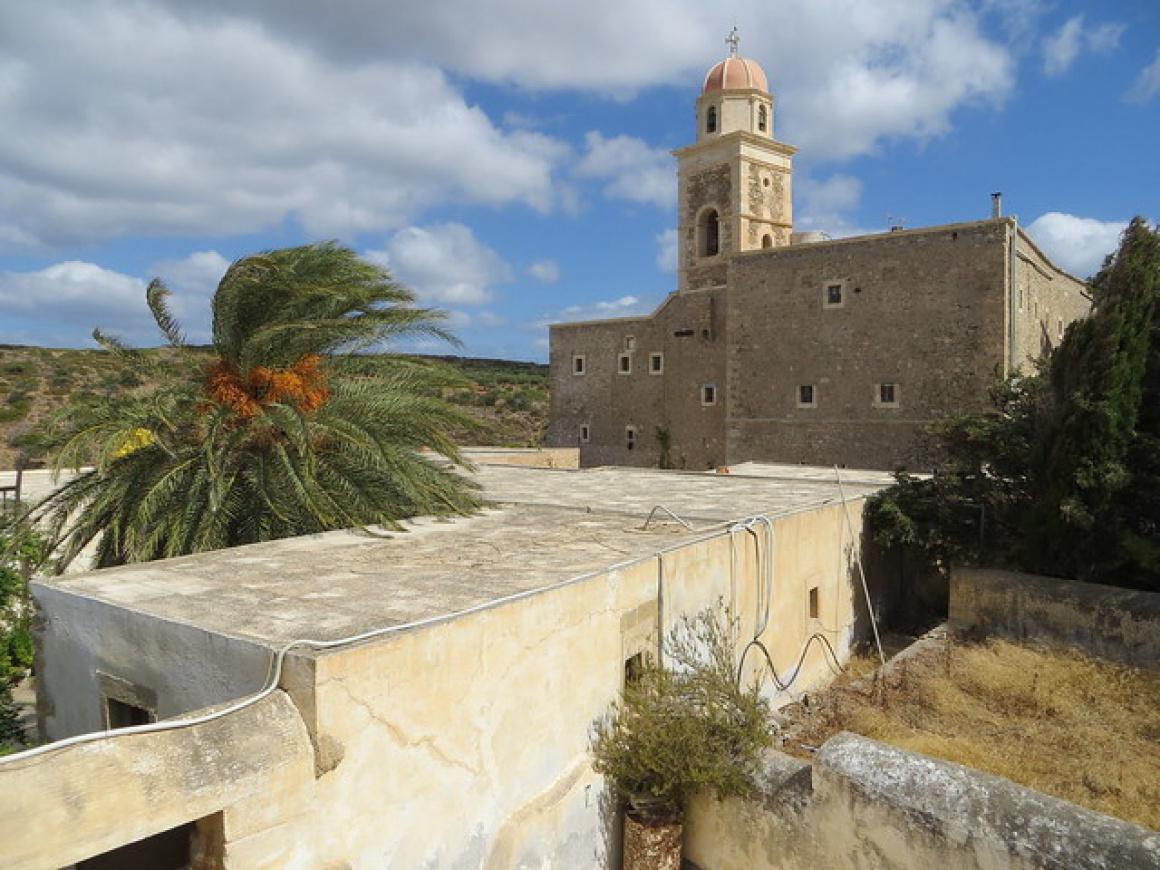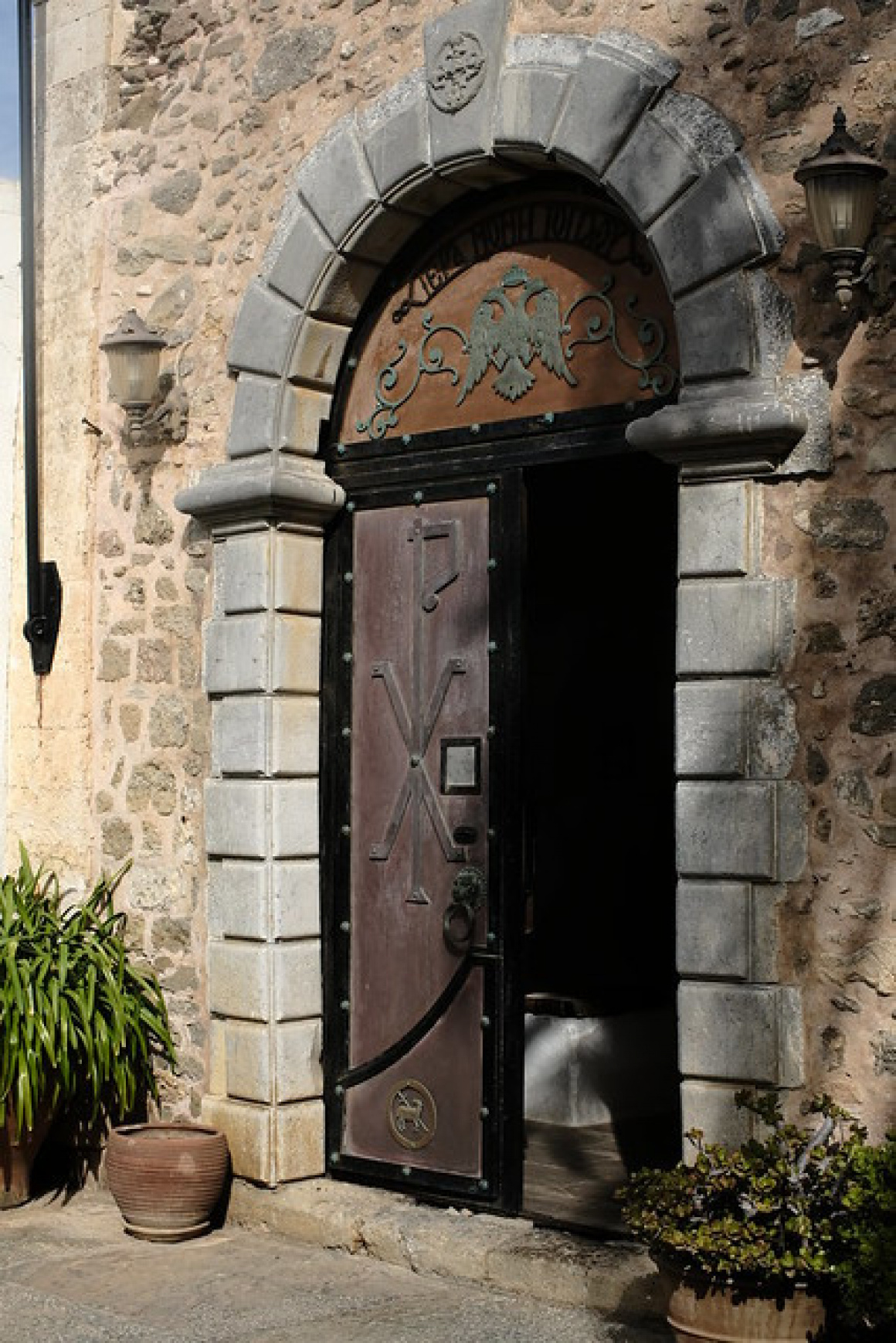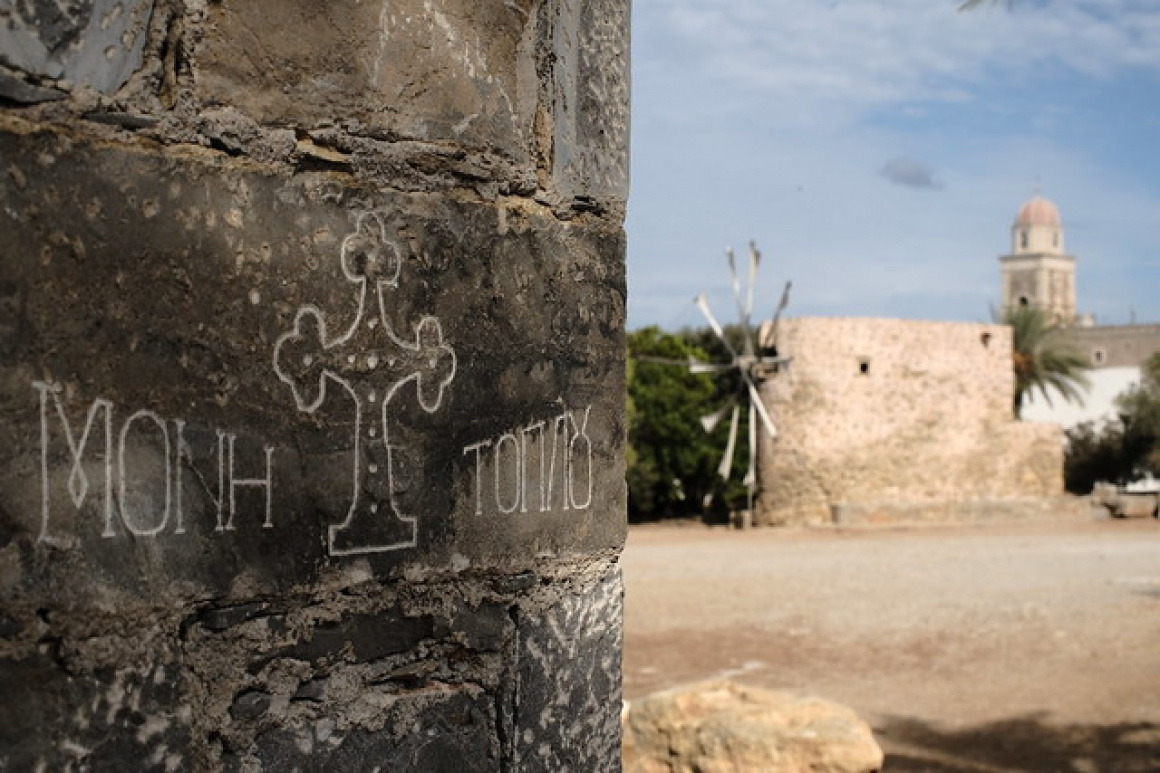Introduction
In the far-flung northeast corner of Crete, amid a landscape of wind-carved hills and sparse vegetation, stands an imposing stone fortress that has withstood pirates, invaders, and the tests of time. From afar, Toplou looks more like a small castle than a monastery – its thick 10-meter high walls and a solitary 33-meter bell tower rise defiantly from a barren plateau. The sense of isolation is palpable; apart from a few outbuildings and vineyards, there’s little else in sight. Step through its heavy wooden gate, however, and you enter an oasis of spirituality, art, and tradition. Toplou Monastery is not only an active Greek Orthodox monastery; it’s also a living museum of Crete’s history, housing precious Byzantine icons and rare manuscripts, and even producing its own renowned wine and olive oil in the traditional way. Visiting Toplou is like peeling back layers of Crete’s soul: you encounter deep religious devotion, tales of resistance against Ottoman rule and Nazi occupation, and the industrious spirit of monks who have turned arid land into fruitful vineyards.
A Fortress of Faith
Toplou’s official name is the Monastery of Panagia Akrotiriani (Our Lady of the Cape), but it’s universally known as “Toplou,” which comes from the Turkish word top meaning “cannon.” Why “Cannon Monastery”? Because during the Turkish period, the Ottomans acknowledged Toplou’s strategic importance and supposedly allowed the monks to keep a cannon for defense. Indeed, Toplou Monastery literally means “Monastery of the Cannon.” This hints at the monastery’s martial past. Built around the 15th century (some sources say the first monastery here was earlier, 14th century), Toplou was fortified to guard against the twin threats of pirates prowling the nearby seas and later, Ottoman raiders. The monastery’s walls form a rectangle, enclosing a courtyard, church, and living quarters, essentially making it a self-contained fortress with only one heavily secured entrance. In its heyday, up to 40 monks and many locals could shelter inside during attacks.

 'Toplou Monastery, Crete, Oct 2013' - Attribution: alljengi
'Toplou Monastery, Crete, Oct 2013' - Attribution: alljengiThroughout the centuries, Toplou has been a beacon of Cretan resistance and culture:
Walking the stone corridors of Toplou, you can almost sense these tumultuous events. Bullet holes from past fights may still scar some walls. The courtyard often impresses visitors with its tranquility now – a well, a few potted plants, perhaps a cat lazing – belying its violent past.
Treasures Inside
Toplou houses a small but excellent museum of religious art and artifacts. For such a remote monastery, it’s astonishing what you can see:
- The prized possession: The icon “Megas ei Kyrie” (Great are You O Lord) painted in 1770 by Ioannis Kornaros. It’s a massive icon, rich in detail, depicting scenes from the liturgy of the Blessing of the Waters. Its intricate design and vibrant colours make it one of the masterpieces of post-Byzantine art in Crete.
- Other icons and manuscripts: Many other icons from the 15th-19th centuries are on display, as well as old manuscripts and codices that survived. Seeing these up close, with their gold leaf and vivid imagery of saints, one appreciates Toplou’s role in keeping Orthodox faith alive through oppressive periods.
- War memorabilia: There is also memorabilia from the war era – like parts of the secret transmitter or photographs of the resistance fighters associated with the monastery, which underscore the patriotism that emanated from these cloisters.
- The chapel (catholicon): A two-aisled basilica with lovely frescoes and a beautifully carved iconostasis. The mix of Venetian influence (baroque elements) and Byzantine tradition in its architecture is notable. When you stand inside the dimly lit church, gaze at the aged frescoes on the walls; those saints have witnessed centuries of prayers and pleas, from monks and villagers alike.
The chapel itself (catholicon) is a two-aisled basilica with lovely frescoes and a beautifully carved iconostasis. The mix of Venetian influence (baroque elements) and Byzantine tradition in its architecture is notable. When you stand inside the dimly lit church, gaze at the aged frescoes on the walls; those saints have witnessed centuries of prayers and pleas, from monks and villagers alike.

 'Toplou Gorge & Toplou monastery' - Attribution: tanja-mueller.eu
'Toplou Gorge & Toplou monastery' - Attribution: tanja-mueller.euWhat makes Toplou unique too is that, beyond being a museum piece, it’s a working monastery with a modern twist: the monks are entrepreneurs in a way, running a winery and olive press using monastery land. Toplou has extensive vineyards and olive groves (you likely passed them on the approach road). They produce award-winning organic wines and raki (grape brandy), as well as excellent extra virgin olive oil. A visit usually includes an opportunity to taste or purchase these products at a small shop. Imagine sampling a robust red wine or a crisp white, knowing the vines grow in the stony soil just outside, tended by the monks. It’s a satisfying connection of heritage and present day. (If you’re a wine enthusiast, consider doing a tasting – the monks or staff are happy to oblige and explain the notes of each variety.)
Exploring the Grounds
When you arrive at Toplou, you’ll likely first notice the bell tower. This tall, square bell tower (built in 1558 and restored later) is iconic – it rises in three levels, each with arched openings, and you might hear its bells peal, echoing across the emptiness. The entry gate beneath is solid; passing through it feels a bit like entering a castle keep.
The monastery complex isn’t huge, but it’s atmospheric.
Key points:
- Courtyard: Look for the old cannon (yes, there’s a cannon displayed in the yard – presumably a nod to the monastery’s name and defense). There’s also a sundial on the wall and some carved inscriptions. The water cistern and well are central features.
- Church: Usually open to visitors (dress modestly as always – shoulders and knees covered; they often provide shawls). Inside, besides icons and frescoes, note the floor made of pebble mosaics and the carved wooden choir stalls. It’s a small church, so it can get crowded if a bus tour arrives, but often you may find it quiet.
- Museum Rooms: Off the courtyard, stairs lead to the upper floor where museum exhibits are. Take time here – signage is usually in English and Greek, describing each icon’s story.
- Shop & Tasting Room: Typically near the exit/entrance, you’ll find the shop with monastery products. Even if you don’t drink, you might try their thyme honey or raisins or the olive oil. If you do purchase wine or olive oil, know that proceeds support the monastery’s upkeep.
Surrounding the monastery walls, you’ll see the monks’ fields and perhaps the modern winery installation a short distance away. Note that Toplou is somewhat isolated: the nearest towns are Sitia (about 10km west) and Palaikastro (8km south). So monks here have historically been quite self-sufficient. One striking thing: wind. The area is often breezy or downright windy (as evidenced by some wind turbines not far off as well). The plateau Toplou sits on, near the cape, funnels winds. Bring a hat that won’t blow away!
Practical Details
Location: 10km east of Sitia, 6km north of Vai Beach. You likely need a car or join a tour. It’s on the road to Vai – many pair the two (morning at Toplou when it’s cooler, midday at Vai Palm Beach for a swim). There’s a parking lot in front of the monastery entrance.
Hours & Admission: Typically open daily except major religious holidays. Summer hours are roughly 9:00-13:00 and 15:00-18:00 (closed midday; in winter it may close earlier). The entrance fee is around €3-€4 which includes museum access. A dress code is enforced: no bare shoulders or legs above the knee. They usually provide wraps if needed. Photography inside the church or museum might be restricted (check signs).
Guided or Not: Often there isn’t a formal guide on site, but the monk at the ticket counter or museum caretaker might give you an impromptu tour if they’re not too busy and you ask. Their passion for the place is evident, and hearing stories first-hand (like how they hid the radio in WWII) can be enriching. Otherwise, the exhibits have explanations.
Amenities: Aside from a basic WC for visitors and the store, there’s not much else. There’s a small café just outside the monastery that sometimes operates, offering cold drinks or coffee (dependent on season). If not, plan to get refreshments in Sitia or Palaikastro.
Nearby Exploration: After Toplou, many head to Vai Palm Beach (a 10-minute drive) or the lesser-known virgin beach of Erimoupolis near ancient Itanos. Also, the village of Palaikastro has some nice tavernas for lunch if you want authentic local food (like katsikaki, stewed goat, or fresh fish).
Toplou’s Wine: If you’re a wine lover, you might already know that Toplou’s labels (with an image of the monastery on them) are respected in Greek wine circles. The dry white (Vilana grape blend) is refreshing in Crete’s heat, and the red (often a blend of indigenous varieties like Liatiko with some international Syrah) is robust. They often produce a sweet dessert wine too (from sun-dried grapes, akin to Italian passito). Buying a bottle or two as souvenirs is common; they pack well for travel.
Unique Aspects
Monastic Hospitality: Occasionally, Toplou has a few monks residing (not many these days, under 10). If you happen upon a service (in the early morning or on a special holy day), you’re welcome to observe quietly – it can be a moving experience hearing Byzantine chant within those ancient walls.
100 Doors Legend: A local legend says Toplou has 100 doors, but only 99 can be found – the hundredth will appear when Cyprus is liberated (a likely reference to Enosis, or to the division of Cyprus). It’s a variant of a common legend associated with many old monasteries (e.g., Arkadi’s legend of 99 doors). While not factual, it adds a mystical folklore to the site.
Sitia Geopark: The region around Toplou is part of the Sitia UNESCO Geopark due to its geological and ecological value (fossils, unique flora). So beyond the monastery, nature enthusiasts find interest in the rock formations and rare plants in this northeastern tip of Crete.
Photography: Toplou is photogenic, especially as you approach or from a slight elevation. The contrast of stone against an often vivid blue sky is striking. The best angle is perhaps from the slight hill to the south where you can capture the entire fortress and the bell tower. Inside, remember no flash on icons if photography is allowed.
Visiting Toplou Monastery transports you to a quieter time. It’s easy to imagine the steadfast monks centuries ago scanning the horizon from the bell tower for pirate ships or quietly copying manuscripts by candlelight in a cell. There’s a sense of continuity: through all that happened – Venetian rule, Turkish sieges, German occupation – the monastery endured and continues its age-old rhythms of prayer and work (ora et labora). When you leave Toplou and return to the modern coastal road, you carry with you a bit of that enduring spirit of Crete: resilient, devout, and deeply tied to the land.
After exploring Toplou, you might be interested in other cultural sites like Arkadi Monastery in Rethymno, which shares a similarly heroic past, or Preveli Monastery in the south with its WWII history. And if you head to Vai Palm Beach next, don’t forget to read our guide on Vai Palm Beach to get the most out of that unique spot!


